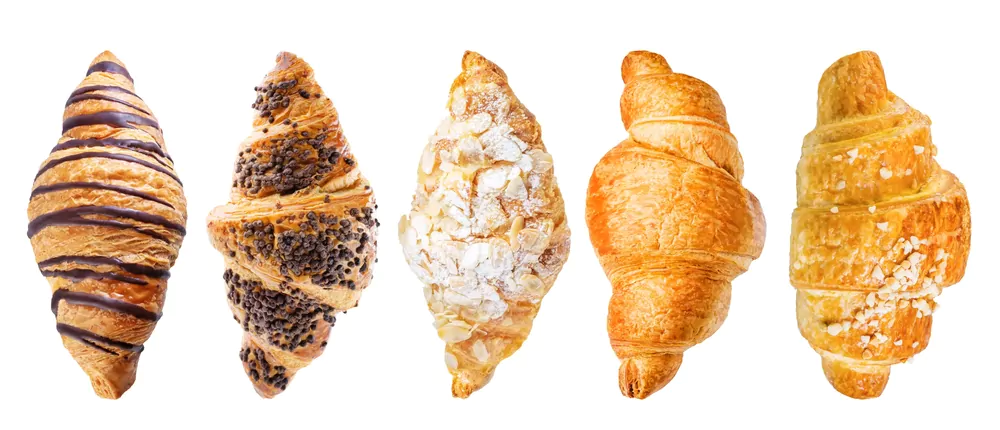How to Eat Croissant? A Gourmet Guide to a Pastry

The pleasure derived from a crispy, flaky, and buttery croissant cannot be overstated. These crescent-shaped pastries originated in France, with a rich history that adds to their irresistible allure. But is there a right way to eat a croissant? While it may seem like a straightforward task, getting the most out of this delectable pastry involves a little know-how.
A croissant is not just a crescent-shaped pastry; it’s a culinary experience that engages all your senses. It’s the anticipation of the first crispy bite, the taste of the buttery interior, and the lingering, satisfying finish. So, join us as we explore how to eat croissant.
1 The Anatomy of a Croissant
Before delving into how to eat a croissant, let’s briefly discuss the pastry’s composition. A traditional croissant is crafted with layers of yeast-leavened dough and butter. These layers are meticulously folded, creating the pastry’s iconic flaky texture when baked.
The outside of a croissant is golden-brown and crispy, while the inside is soft, airy, and slightly chewy. High-quality croissants have a rich, buttery flavor with a hint of sweetness, making them a delightful treat for breakfast or a sophisticated companion to your afternoon tea.
2 A Fresh Perspective: Timing Matters

As with most pastries, croissants are best enjoyed fresh. Straight out of the oven, a croissant reaches the zenith of its texture – a perfect symphony of the crunch from the crust and the tender, melt-in-your-mouth interior. Hence, if you want to truly appreciate a croissant, plan your indulgence around the bakery’s baking schedule. Early mornings are often the best bet. However, if you’re buying a croissant to eat later, a quick stint in the oven can help revive its texture.
3 The Ceremony of Eating: Appreciating the Croissant
When it comes to eating a croissant, some might argue that there are no hard and fast rules. But for those seeking a true experience, there are certain etiquettes you can follow to elevate your croissant appreciation journey.
1. Observe and Admire

Before you dive into your croissant, take a moment to appreciate its visual attributes. Admire the golden hue of the crust, which is the result of the Maillard reaction during baking. Notice the symmetrical shape, which is a testament to the baker’s skill. An evenly browned crust is a sign of a well-baked croissant, while a pale or unevenly browned crust might signal issues with the baking process.
2. Listen to the Sound
Pick up the croissant and gently squeeze it. It should make a distinctive, crackling sound, a sign of a good, crispy crust. This is the music of a well-made croissant.
3. The First Bite
Take your first bite from the pointed end of the croissant. Doing so allows you to experience the contrast between the crispy outer layer and the soft interior. It’s also a moment of anticipation, as you’re getting just a tease of the flavors that are about to flood your senses.
4. The Second Bite and Beyond
Once you’ve savored the initial taste, it’s time to explore the heart of the croissant. The middle is often the most buttery part, where all the flavors coalesce. You’ll likely find that every bite is slightly different, a delicate interplay between the buttery interior and the crispy crust.
5. Using Cutlery

If you’re enjoying your croissant in a more formal setting, it’s acceptable to use a knife and fork. This can be particularly helpful when you’re eating a filled croissant to avoid any potential mess.
4 Perfect Pairings

Croissants are versatile pastries that can be paired with a variety of beverages and spreads. A classic French approach would be to enjoy your croissant with a cup of coffee or hot chocolate. For a lighter alternative, a croissant with tea can be an elegant choice.
If you fancy a little extra flavor, you might consider a spread. Butter, jam, and honey are popular choices, though it’s essential to remember that a high-quality croissant has enough flavor to stand on its own.
5 The Wonderful World of Croissants: Variations on a Classic

While the traditional butter croissant is a joy unto itself, there are many delicious variations that each bring their unique twist to the table.
- Pain au Chocolat: This is essentially a chocolate-filled croissant. Instead of the crescent shape, it’s typically rectangular, with rich, melted chocolate in the center.
- Almond Croissant: An almond croissant is a croissant filled with almond cream and topped with sliced almonds and powdered sugar. It’s incredibly rich and quite sweet.
- Ham and Cheese Croissant: This savory take on the croissant typically involves ham and cheese baked into the dough or added later as a filling.
- Pain aux Raisins: Translated as ‘raisin bread’, this variant is a spiral pastry often made with the same laminated dough as a croissant and dotted with raisins.
- Croissant aux Beurre: This is the extra buttery version of the classic croissant, and as you might expect, it has an even richer, more indulgent flavor.
6 The Art of Choosing a Quality Croissant at a Bakery
Choosing a quality croissant can be the difference between a mediocre experience and pastry perfection. Here are some tips to help you make the right choice:
- Check the color: Look for an even, golden-brown color. Pale croissants may not be fully baked, while very dark croissants might be over-baked.
- Examine the structure: Good croissants have a honeycomb-like structure when you tear them apart. This is due to the layering of the dough and butter.
- Feel the weight: High-quality croissants feel light for their size. If it feels heavy, it might be under-proofed or poorly baked.
- Give it a sniff: Croissants should have a rich, buttery aroma. If it smells yeasty or like baking flour, it might not be made with high-quality ingredients or techniques.
- Ask about the ingredients: Traditional French croissants are made with high-quality butter, flour, yeast, milk, sugar, and salt. Some bakeries might use margarine instead of butter, which can affect the flavor and quality.
7 Final Thoughts
In the end, how to eat a croissant depends heavily on personal preference. Whether you enjoy your croissant at a fancy brunch spot, a roadside café, or in the comfort of your own home, the goal is to savor every bite. By appreciating its texture, aroma, and taste, you’ll experience the croissant in all its glory, making it more than just a quick bite, but a culinary adventure in itself.
Also, if you have a sweet tooth, check out our blog on the art of cup cake design for your next tea party!
Community Q&A
About This Article
Hardik Jethva is an experienced author of the BestCheck family. Working from scratch, he has developed an amazing interest in testing and writing about different products in a transparent manner. His writing skills got more audience for BestCheck. Apart from his professional life, Hardik has his eyes on travelling, meditation, eating healthy food, socializing with people, and car rides.
This article has been viewed 450 times.



